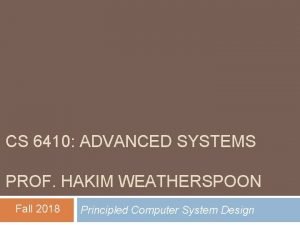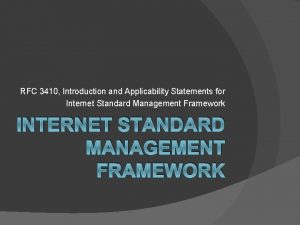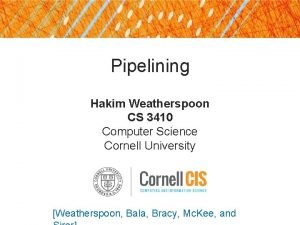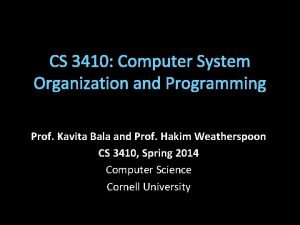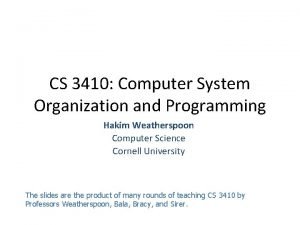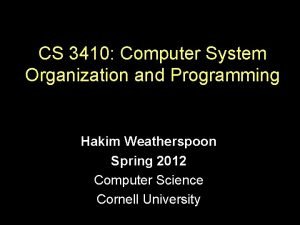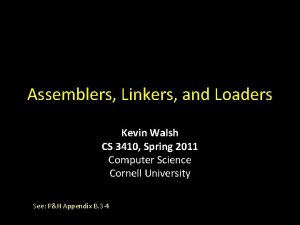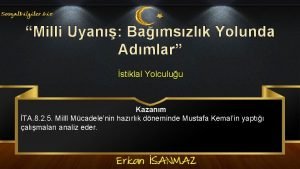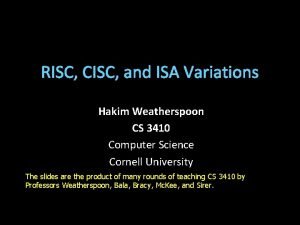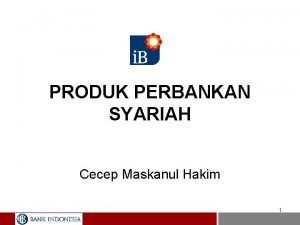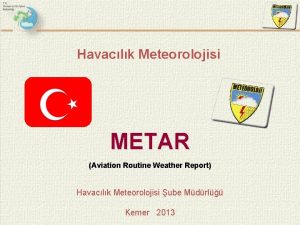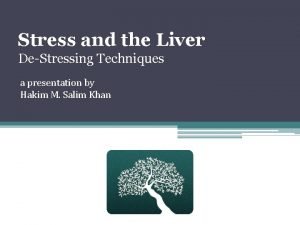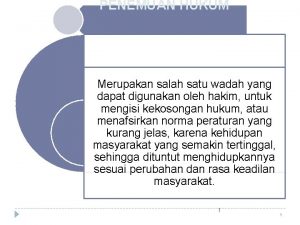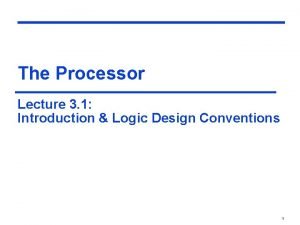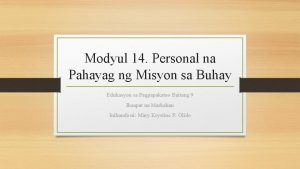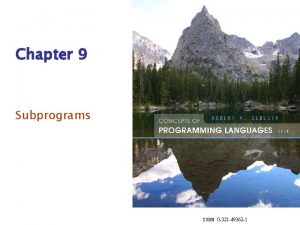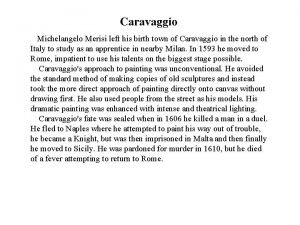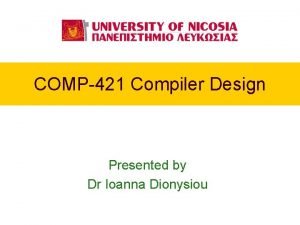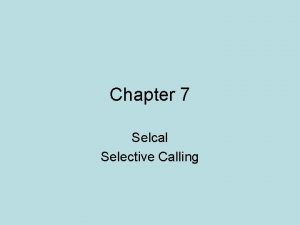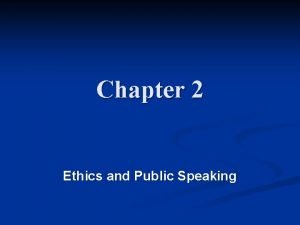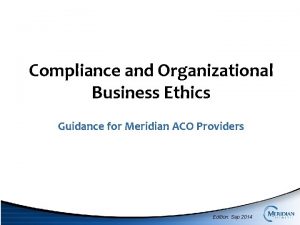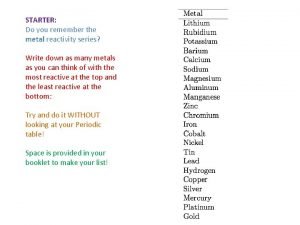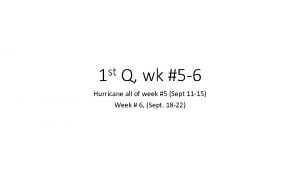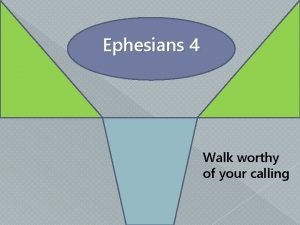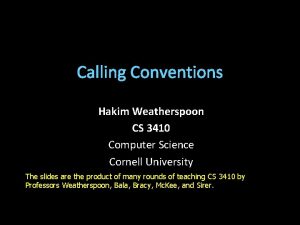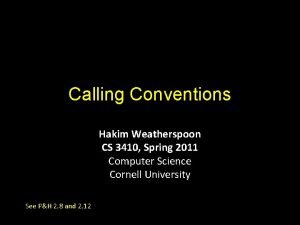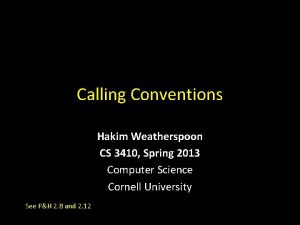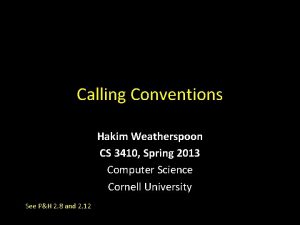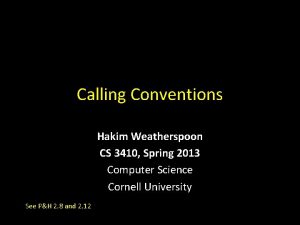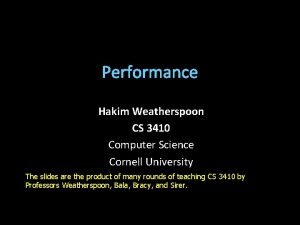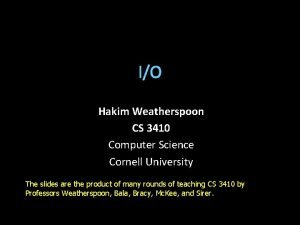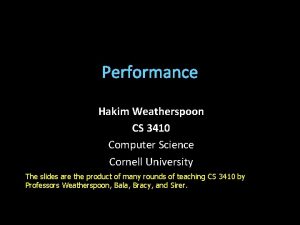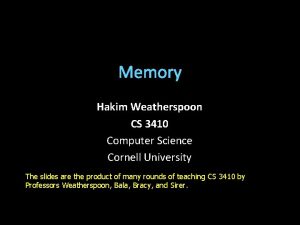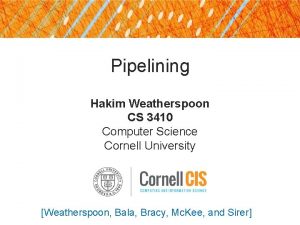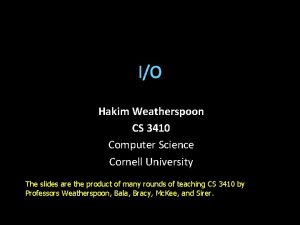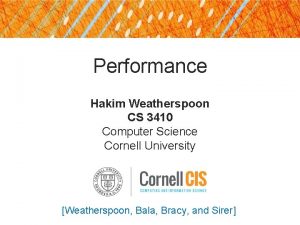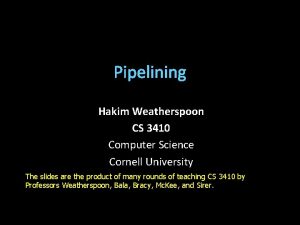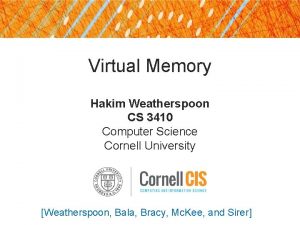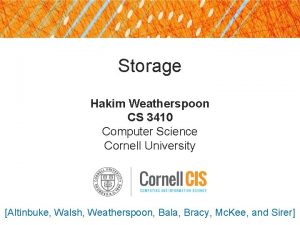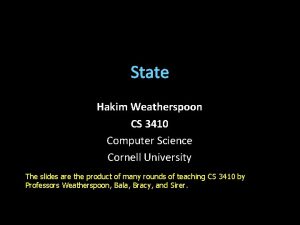Calling Conventions Hakim Weatherspoon CS 3410 Computer Science










![How does a function call work? int main (int argc, char* argv[ ]) { How does a function call work? int main (int argc, char* argv[ ]) {](https://slidetodoc.com/presentation_image/15f01c59cdbbd9c689069487cd6d6998/image-11.jpg)





![JAL / JR for Recursion? int main (int argc, char* argv[ ]) { int JAL / JR for Recursion? int main (int argc, char* argv[ ]) { int](https://slidetodoc.com/presentation_image/15f01c59cdbbd9c689069487cd6d6998/image-17.jpg)
![JAL / JR for Recursion? int main (int argc, char* argv[ ]) { int JAL / JR for Recursion? int main (int argc, char* argv[ ]) { int](https://slidetodoc.com/presentation_image/15f01c59cdbbd9c689069487cd6d6998/image-18.jpg)










































![Caller-Saved Registers in Practice main: … [use $8 & $9] … addiu $sp, -8 Caller-Saved Registers in Practice main: … [use $8 & $9] … addiu $sp, -8](https://slidetodoc.com/presentation_image/15f01c59cdbbd9c689069487cd6d6998/image-61.jpg)
![Caller-Saved Registers in Practice main: … [use $t 0 & $t 1] … addiu Caller-Saved Registers in Practice main: … [use $t 0 & $t 1] … addiu](https://slidetodoc.com/presentation_image/15f01c59cdbbd9c689069487cd6d6998/image-62.jpg)




















- Slides: 82

Calling Conventions Hakim Weatherspoon CS 3410 Computer Science Cornell University The slides are the product of many rounds of teaching CS 3410 by Professors Weatherspoon, Bala, Bracy, Mc. Kee, and Sirer.

Big Picture: Where are we now? A compute jump/branch targets alu B D register file D memory +4 IF/ID ID/EX M dout forward unit Execute EX/MEM Memory ctrl Instruction Decode Instruction Fetch ctrl detect hazard din memory ctrl extend new pc B control imm inst PC addr Write. Back MEM/WB

Big Picture: Where are we going? C compiler int x = 10; x = 2 * x + 15; r 0 = 0 MIPS r 5 = r 0 + 10 addiu r 5, r 0, 10 assembly muli r 5, 2 r 5 = r 5<<1 #r 5 = r 5 * 2 r 5 = r 15 + 15 assembler addiu r 5, 15 op = addiu r 0 r 5 10 machine 001000001010000001010 000000010100001000000 code 001000001010000001111 op = addiu r 5 15 CPU op = r-type r 5 shamt=1 func=sll Circuits Gates Transistors Silicon 3

Goals for this week Calling Convention for Procedure Calls Enable code to be reused by allowing code snippets to be invoked Will need a way to • call the routine (i. e. transfer control to procedure) • pass arguments – fixed length, variable length, recursively • return to the caller – Putting results in a place where caller can find them • Manage register

Calling Convention for Procedure Calls Transfer Control • Caller Routine • Routine Caller Pass Arguments to and from the routine • fixed length, variable length, recursively • Get return value back to the caller Manage Registers • Allow each routine to use registers • Prevent routines from clobbering each others’ data What is a Convention? Warning: There is no one true MIPS calling convention. 5 lecture != book != gcc != spim != web

Cheat Sheet and Mental Model for Today A compute jump/branch targets alu B D register file D memory +4 IF/ID ID/EX M dout forward unit Execute EX/MEM Memory ctrl Instruction Decode Instruction Fetch ctrl detect hazard din memory ctrl extend new pc B control imm inst PC addr Write. Back MEM/WB How do we share registers and use memory when making procedure calls?

Cheat Sheet and Mental Model for Today • • first four arg words passed in $a 0, $a 1, $a 2, $a 3 remaining arg words passed in parent’s stack frame return value (if any) in $v 0, $v 1 stack frame at $sp – contains $ra (clobbered on JAL to sub-functions) $fp – contains local vars (possibly clobbered by sub-functions) – contains extra arguments to sub-functions – contains space for first 4 arguments to sub-functions • callee save regs are preserved • caller save regs are not • Global data accessed via $gp saved ra saved fp saved regs ($s 0. . . $s 7) locals $sp outgoing args

MIPS Register Return address: $31 (ra) Stack pointer: $29 (sp) Frame pointer: $30 (fp) First four arguments: $4 -$7 (a 0 -a 3) Return result: $2 -$3 (v 0 -v 1) Callee-save free regs: $16 -$23 (s 0 -s 7) Caller-save free regs: $8 -$15, $24, $25 (t 0 -t 9) Reserved: $26, $27 Global pointer: $28 (gp) Assembler temporary: $1 (at)

r 0 r 1 r 2 r 3 r 4 r 5 r 6 r 7 r 8 r 9 r 10 r 11 r 12 r 13 r 14 r 15 MIPS Register Conventions $zero $at assembler temp $v 0 function return values $v 1 $a 0 $a 1 function arguments $a 2 $a 3 $t 0 $t 1 $t 2 $t 3 temps $t 4 (caller save) $t 5 $t 6 $t 7 r 16 r 17 r 18 r 19 r 20 r 21 r 22 r 23 r 24 r 25 r 26 r 27 r 28 r 29 r 30 r 31 $s 0 $s 1 $s 2 $s 3 $s 4 $s 5 $s 6 $s 7 $t 8 $t 9 $k 0 $k 1 $gp $sp $fp $ra saved (callee save) more temps (caller save) reserved for kernel global data pointer stack pointer frame pointer return address

Calling Convention for Procedure Calls Transfer Control • Caller Routine • Routine Caller Pass Arguments to and from the routine • fixed length, variable length, recursively • Get return value back to the caller Manage Registers • Allow each routine to use registers • Prevent routines from clobbering each others’ data What is a Convention? Warning: There is no one true MIPS calling convention. 10 lecture != book != gcc != spim != web
![How does a function call work int main int argc char argv How does a function call work? int main (int argc, char* argv[ ]) {](https://slidetodoc.com/presentation_image/15f01c59cdbbd9c689069487cd6d6998/image-11.jpg)
How does a function call work? int main (int argc, char* argv[ ]) { int n = 9; int result = myfn(n); } int myfn(int n) { int f = 1; int i = 1; int j = n – 1; while(j >= 0) { f *= i; i++; j = n - i; } return f; }

Jumps are not enough 1 main: … j myfn after 1: myfn: 2 add $1, $2, $3 … j after 1 Jumps to the callee Jumps back 12

Jumps are not enough 1 main: 3 j myfn after 1: … 2 add $1, $2, $3 j myfn after 2: myfn: 4 sub $3, $4, $5 … j after 1 j after 2 ? ? ? Change target on the fly ? ? ? Jumps to the callee Jumps back What about multiple sites? 13

Takeaway 1: Need Jump And Link JAL (Jump And Link) instruction moves a new value into the PC, and simultaneously saves the old value in register $31 (aka $ra or return address) Thus, can get back from the subroutine to the instruction immediately following the jump by transferring control back to PC in register $31

Jump-and-Link / Jump Register First call r 31 1 main: jal myfn after 1: myfn: … 2 add $1, $2, $3 jal myfn … jr $31 after 2: sub $3, $4, $5 JAL saves the PC in register $31 Subroutine returns by jumping to $31 15

Jump-and-Link / Jump Register Second call r 31 1 main: 3 jal myfn after 1: 2 add $1, $2, $3 jal myfn after 2: myfn: … … jr $31 4 sub $3, $4, $5 JAL saves the PC in register $31 Subroutine returns by jumping to $31 What happens for recursive invocations? 16
![JAL JR for Recursion int main int argc char argv int JAL / JR for Recursion? int main (int argc, char* argv[ ]) { int](https://slidetodoc.com/presentation_image/15f01c59cdbbd9c689069487cd6d6998/image-17.jpg)
JAL / JR for Recursion? int main (int argc, char* argv[ ]) { int n = 9; int result = myfn(n); } int myfn(int n) { int f = 1; int i = 1; int j = n – 1; while(j >= 0) { f *= i; i++; j = n - i; } return f; }
![JAL JR for Recursion int main int argc char argv int JAL / JR for Recursion? int main (int argc, char* argv[ ]) { int](https://slidetodoc.com/presentation_image/15f01c59cdbbd9c689069487cd6d6998/image-18.jpg)
JAL / JR for Recursion? int main (int argc, char* argv[ ]) { int n = 9; int result = myfn(n); } int myfn(int n) { if(n > 0) { return n * myfn(n - 1); } else { return 1; } }

JAL / JR for Recursion? First call r 31 1 main: myfn: if (test) jal myfn after 1: add $1, $2, $3 after 2: jr $31 Problems with recursion: 19

JAL / JR for Recursion? Recursive Call 1 main: 2 myfn: if (test) jal myfn after 1: add $1, $2, $3 r 31 after 2: jr $31 Problems with recursion: 20

JAL / JR for Recursion? Return from Recursive Call 1 2 myfn: main: if (test) jal myfn after 1: add $1, $2, $3 r 31 3 after 2: jr $31 Problems with recursion: 21

Need a “Call Stack” Call stack • contains activation records (aka stack frames) high mem Each activation record contains • the return address for that invocation • the local variables for that procedure $31 = sp A stack pointer (sp) keeps track of the top of the stack • dedicated register ($29) on the MIPS Manipulated by push/pop operations • push: move sp down, store • pop: load, move sp up low mem after 1

Cheat Sheet and Mental Model for Today A compute jump/branch targets alu B D register file D memory +4 IF/ID ID/EX M dout forward unit Execute EX/MEM Memory ctrl Instruction Decode Instruction Fetch ctrl detect hazard din memory ctrl extend new pc B control imm inst PC addr Write. Back MEM/WB

Need a “Call Stack” Call stack • contains activation records (aka stack frames) high mem Each activation record contains • the return address for that invocation • the local variables for that procedure A stack pointer (sp) keeps track of the top of the stack • dedicated register ($29) on the MIPS Manipulated by push/pop operations • push: move sp down, store • pop: load, move sp up sp $31 = after 1 $31 = after 2 sp Push: ADDIU $sp, -4 SW $31, 0 ($sp) low mem

Need a “Call Stack” Call stack • contains activation records (aka stack frames) high mem Each activation record contains • the return address for that invocation • the local variables for that procedure A stack pointer (sp) keeps track of the top of the stack • dedicated register ($29) on the MIPS Manipulated by push/pop operations • push: move sp down, store • pop: load, move sp up sp $31 = after 1 $31 = after 2 sp Push: ADDIU $sp, -4 SW $31, 0 ($sp) Pop: LW $31, 0 ($sp) ADDIU $sp, 4 low mem JR $31

Need a “Call Stack” 1 main: jal myfn after 1: add $1, $2, $3 2 myfn: addiu $sp, -4 sw $31, 0($sp) if (test) jal myfn after 2: lw $31, 0($sp) addiu $sp, 4 jr $31 high mem after 1 after 2 sp low mem Stack used to save and restore contents of $31

Need a “Call Stack” 1 main: jal myfn after 1: add $1, $2, $3 2 myfn: addiu $sp, -4 sw $31, 0($sp) if (test) jal myfn after 2: lw $31, 0($sp) addiu $sp, 4 jr $31 high mem after 1 after 2 sp low mem Stack used to save and restore contents of $31

Stack Growth (Call) Stacks start at a high address in memory Stacks grow down as frames are pushed on • Note: data region starts at a low address and grows up • The growth potential of stacks and data region are not artificially limited

An executing program in memory 0 xfffffffc top system reserved 0 x 80000000 0 x 7 ffffffc stack dynamic data (heap) 0 x 10000000 0 x 00400000 0 x 0000 static data code (text) . text system reserved bottom

An executing program in memory 0 xfffffffc top system reserved 0 x 80000000 0 x 7 ffffffc stack “Data Memory” dynamic data (heap) 0 x 10000000 0 x 00400000 0 x 0000 static data code (text) system reserved “Program Memory” bottom 30

Anatomy of an executing program A compute jump/branch targets IF/ID ID/EX D M dout memory forward unit Execute Stack, Data, Code Stored in Memory EX/MEM Memory ctrl Instruction Decode din B control detect hazard Instruction Fetch D B addr extend new pc alu ctrl inst +4 Code Stack, Data, Stored in Memory PC register file $29 ($sp) $31 ($ra) imm memory Write. Back MEM/WB

An executing program in memory 0 xfffffffc top system reserved 0 x 80000000 0 x 7 ffffffc stack “Data Memory” dynamic data (heap) 0 x 10000000 0 x 00400000 0 x 0000 static data code (text) system reserved “Program Memory” bottom 32

The Stack contains stack frames (aka “activation records”) • • 1 stack frame per dynamic function Exists only for the duration of function Grows down, “top” of stack is $sp, r 29 Example: lw $r 1, 0($sp) puts word at top of stack into $r 1 Each stack frame contains: • Local variables, return address (later), register backups (later) int main(…) {. . . myfn(x); } int myfn(int n) {. . . myfn(); } system reserved stack $sp main stack frame myfn stack frame heap static data code system reserved 33

The Heap holds dynamically allocated memory • Program must maintain pointers to anything allocated • • Example: if $r 3 holds x lw $r 1, 0($r 3) gets first word x points to • Data exists from malloc() to free() system reserved void some_function() { int *x = malloc(1000); int *y = malloc(2000); free(y); int *z = malloc(3000); } x y z stack 3000 bytes 2000 bytes heap static data code system reserved 1000 bytes 34

Data Segment Data segment contains global variables • Exist for all time, accessible to all routines • Accessed w/global pointer • • $gp, r 28, points to middle of segment Example: lw $r 1, 0($gp) gets middle-most word (here, max_players) int max_players = 4; int main(. . . ) {. . . } system reserved stack heap static data code system reserved gp 4 35

Globals and Locals Variables Visibility Lifetime Location Function-Local Global Dynamic int n = 100; int main (int argc, char* argv[ ]) { int i, m = n, sum = 0; int* A = malloc(4*m + 4); for (i = 1; i <= m; i++) { sum += i; A[i] = sum; } printf ("Sum 1 to %d is %dn", n, sum); } 36

Takeaway 2: Need a Call Stack JAL (Jump And Link) instruction moves a new value into the PC, and simultaneously saves the old value in register $31 (aka $ra or return address) Thus, can get back from the subroutine to the instruction immediately following the jump by transferring control back to PC in register $31 Need a Call Stack to return to correct calling procedure. To maintain a stack, need to store an activation record (aka a “stack frame”) in memory. Stacks keep track of the correct return address by storing the contents of $31 in memory (the stack).

Calling Convention for Procedure Calls Transfer Control • Caller Routine • Routine Caller Pass Arguments to and from the routine • fixed length, variable length, recursively • Get return value back to the caller Manage Registers • Allow each routine to use registers • Prevent routines from clobbering each others’ data 38

Next Goal Need consistent way of passing arguments and getting the result of a subroutine invocation

Arguments & Return Values Need consistent way of passing arguments and getting the result of a subroutine invocation Given a procedure signature, need to know where arguments should be placed • • • int min(int a, int b); int subf(int a, int b, int c, int d, int e); int isalpha(char c); int treesort(struct Tree *root); struct Node *create. Node(); struct Node mynode(); Too many combinations of char, short, int, void *, struct, etc. • MIPS treats char, short, int and void * identically

Simple Argument Passing (1 -4 args) main() { int x = myfn(6, 7); x = x + 2; } main: li $a 0, 6 li $a 1, 7 jal myfn addiu $r 1, $v 0, 2 First four arguments: passed in registers $4 -$7 • aka $a 0, $a 1, $a 2, $a 3 Returned result: passed back in a register • Specifically, $2, aka $v 0 Note: This is not the entire story for 1 -4 arguments. Please see the Full Story slides. 41

Conventions so far: • args passed in $a 0, $a 1, $a 2, $a 3 • return value (if any) in $v 0, $v 1 • stack frame at $sp – contains $ra (clobbered on JAL to sub-functions) Q: What about argument lists?

Many Arguments (5+ args) main() { myfn(0, 1, 2, 3, 4, 5); … } main: li $a 0, 0 li $a 1, 1 li $a 2, 2 li $a 3, 3 addiu $sp, -8 li $8, 4 sw $8, 0($sp) li $8, 5 sw $8, 4($sp) jal myfn First four arguments: passed in $4 -$7 • aka $a 0 -$a 3 sp 5 4 Subsequent arguments: ”spill” onto the stack Note: This is not the entire story for 5+ arguments. Please see the Full Story slides. 43

Argument Passing: the Full Story main() { myfn(0, 1, 2, 3, 4, 5); … } sp 5 main: 4 li $a 0, 0 space for a 3 li $a 1, 1 space for a 2 li $a 2, 2 li $a 3, 3 space for a 1 addiu $sp, -24 sp space for a 0 li $8, 4 sw $8, 16($sp) li $8, 5 sw $8, 20($sp) jal myfn 20($sp) 16($sp) 12($sp) Arguments 1 -4: passed in $4 -$7 room on stack Arguments 5+: placed on stack 8($sp) 4($sp) 0($sp) Stack decremented by max(16, #args x 4) Here: max (16, 24) = 4424

Pros of Argument Passing Convention • Consistent way of passing arguments to and from subroutines • Creates single location for all arguments • Caller makes room for $a 0 -$a 3 on stack • Callee must copy values from $a 0 -$a 3 to stack callee may treat all args as an array in memory • Particularly helpful for functions w/ variable length inputs: printf(“Scores: %d %d %dn”, 1, 2, 3); • Aside: not a bad place to store inputs if callee needs to call a function (your input cannot stay in $a 0 if you need to call another function!) 45

Frame Layout & the Frame Pointer sp blue’s Ret Addr blue’s 5 stack 4 frame space for a 3 space for a 2 space for a 1 sp space for a 0 blue() { pink(0, 1, 2, 3, 4, 5); } 46

Frame Layout & the Frame Pointer Notice blue’s Ret Addr • Pink’s arguments are on blue’s stack blue’s 5 • sp changes as functions call other stack 4 functions, complicates accesses frame space for a 3 Convenient to keep pointer to space for a 2 bottom of stack == frame pointer space for a 1 $30, aka $fp sp space for a 0 can be used to restore $sp on exit pink’s Ret Addr fp sp pink’s stack frame blue() { pink(0, 1, 2, 3, 4, 5); } pink(int a, int b, int c, int d, int e, int f) { … 47 }

• • Conventions so far first four arg words passed in $a 0, $a 1, $a 2, $a 3 remaining arg words passed in parent’s stack frame return value (if any) in $v 0, $v 1 stack frame ($fp to $sp) contains: – $ra (clobbered on JAL to sub-functions) – space for 4 arguments to Callees – arguments 5+ to Callees

r 0 r 1 r 2 r 3 r 4 r 5 r 6 r 7 r 8 r 9 r 10 r 11 r 12 r 13 r 14 r 15 MIPS Register Conventions so far: $zero $at assembler temp $v 0 function return values $v 1 $a 0 $a 1 function arguments $a 2 $a 3 r 16 r 17 r 18 r 19 r 20 r 21 r 22 r 23 r 24 r 25 r 26 $k 0 r 27 $k 1 r 28 r 29 r 30 r 31 $ra Pseudo-Instructions e. g. BLZ SLT $at BNE $at, 0, L reserved for OS kernel return address

C & MIPS: the fine print C allows passing whole structs • int dist(struct Point p 1, struct Point p 2); • Treated as collection of consecutive 32 -bit arguments – Registers for first 4 words, stack for rest • Better: int dist(struct Point *p 1, struct Point *p 2); Where are the arguments to: void sub(int a, int b, int c, int d, int e); void isalpha(char c); void treesort(struct Tree *root); Where are the return values from: struct Node *create. Node(); struct Node mynode(); Many combinations of char, short, int, void *, struct, etc. • MIPS treats char, short, int and void * identically

Globals and Locals Global variables are allocated in the “data” region of the program • Exist for all time, accessible to all routines Local variables are allocated within the stack frame • Exist solely for the duration of the stack frame Dangling pointers are pointers into a destroyed stack frame • C lets you create these, Java does not • int *foo() { int a; return &a; }

Global and Locals How does a function load global data? • global variables are just above 0 x 10000000 Convention: global pointer • $28 is $gp (pointer into middle of global data section) $gp = 0 x 10008000 • Access most global data using LW at $gp +/- offset LW $v 0, 0 x 8000($gp) LW $v 1, 0 x 7 FFF($gp)

Anatomy of an executing program 0 xfffffffc top system reserved 0 x 80000000 0 x 7 ffffffc stack dynamic data (heap) $gp 0 x 10000000 static data 0 x 00400000 0 x 0000 code (text) system reserved bottom

Frame Pointer It is often cumbersome to keep track of location of data on the stack • The offsets change as new values are pushed onto and popped off of the stack Keep a pointer to the bottom of the top stack frame • Simplifies the task of referring to items on the stack A frame pointer, $30, aka $fp • Value of $sp upon procedure entry • Can be used to restore $sp on exit

Conventions so far • • first four arg words passed in $a 0 -$a 3 remaining args passed in parent’s stack frame return value (if any) in $v 0, $v 1 stack frame ($fp to $sp) contains: • $ra (clobbered on JALs) • space for 4 arguments to Callees • arguments 5+ to Callees • global data accessed via $gp

Calling Convention for Procedure Calls Transfer Control • Caller Routine • Routine Caller Pass Arguments to and from the routine • fixed length, variable length, recursively • Get return value back to the caller Manage Registers • Allow each routine to use registers • Prevent routines from clobbering each others’ data 56

Next Goal What convention should we use to share use of registers across procedure calls?

Register Management Functions: • Are compiled in isolation • Make use of general purpose registers • Call other functions in the middle of their execution • • These functions also use general purpose registers! No way to coordinate between caller & callee Need a convention for register management 58

Caller-saved Registers that the caller cares about: $t 0… $t 9 About to call a function? • • Need value in a t-register after function returns? save it to the stack before fn call restore it from the stack after fn returns Don’t need value? do nothing Suppose: $t 0 holds x $t 1 holds y $t 2 holds z Where do we save and restore? Functions • Can freely use these registers • Must assume that their contents are destroyed by other functions void myfn(int a) { int x = 10; int y = max(x, a); int z = some_fn(y); return (z + y); } 60

Callee-saved Registers a function intends to use: $s 0… $s 9 About to use an s-register? You MUST: • • Save the current value on the stack before using Restore the old value from the stack before fn returns Functions • Must save these registers before using them • May assume that their contents are preserved even across fn calls Suppose: $s 0 holds x $s 1 holds y $s 2 holds z Where do we save and restore? void myfn(int a) { int x = 10; int y = max(x, a); int z = some_fn(y); return (z + y); } 61
![CallerSaved Registers in Practice main use 8 9 addiu sp 8 Caller-Saved Registers in Practice main: … [use $8 & $9] … addiu $sp, -8](https://slidetodoc.com/presentation_image/15f01c59cdbbd9c689069487cd6d6998/image-61.jpg)
Caller-Saved Registers in Practice main: … [use $8 & $9] … addiu $sp, -8 sw $9, 4($sp) sw $8, 0($sp) jal mult lw $9, 4($sp) lw $8, 0($sp) addiu $sp, 8 … [use $8 & $9] Assume the registers are free for the taking, use with no overhead Since subroutines will do the same, must protect values needed later: Save before fn call Restore after fn call Notice: Good registers to use if you don’t call too many functions or if the values don’t matter later on anyway. 62
![CallerSaved Registers in Practice main use t 0 t 1 addiu Caller-Saved Registers in Practice main: … [use $t 0 & $t 1] … addiu](https://slidetodoc.com/presentation_image/15f01c59cdbbd9c689069487cd6d6998/image-62.jpg)
Caller-Saved Registers in Practice main: … [use $t 0 & $t 1] … addiu $sp, -8 sw $t 1, 4($sp) sw $t 0, 0($sp) jal mult lw $t 1, 4($sp) lw $t 0, 0($sp) addiu $sp, 8 … [use $t 0 & $t 1] Assume the registers are free for the taking, use with no overhead Since subroutines will do the same, must protect values needed later: Save before fn call Restore after fn call Notice: Good registers to use if you don’t call too many functions or if the values don’t matter later on anyway. 63

Callee-Saved Registers in Practice main: addiu $sp, -32 sw $31, 28($sp) sw $30, 24($sp) sw $17, 20($sp) sw $16, 16($sp) addiu $fp, $sp, 28 … [use $16 and $17] … lw $31, 28($sp) lw $30, 24($sp) lw $17, 20$sp) lw $16, 16($sp) addiu $sp, 32 jr $31 Assume caller is using the registers Save on entry Restore on exit Notice: Good registers to use if you make a lot of function calls and need values that are preserved across all of them. Also, good if caller is actually using the registers, otherwise the save and restores are wasted. But hard to know this. 64

Callee-Saved Registers in Practice main: addiu $sp, -32 sw $ra, 28($sp) sw $fp, 24($sp) sw $s 1, 20($sp) sw $s 0, 16($sp) addiu $fp, $sp, 28 … [use $s 0 and $s 1] … lw $ra, 28($sp) lw $fp, 24($sp) lw $s 1, 20$sp) lw $s 0, 16($sp) addiu $sp, 32 jr $ra Assume caller is using the registers Save on entry Restore on exit Notice: Good registers to use if you make a lot of function calls and need values that are preserved across all of them. Also, good if caller is actually using the registers, otherwise the save and restores are wasted. But hard to know this. 65

Frame Layout on Stack fp saved ra saved fp saved regs ($s 0. . . $s 7) locals sp outgoing args Assume a function uses two calleesave registers. How do we allocate a stack frame? How large is the stack frame? What should be stored in the stack frame? Where should everything be stored? 66

Frame Layout on Stack fp saved ra saved fp saved regs ($s 0. . . $s 7) locals sp outgoing args ADDIU $sp, -32 SW $ra, 28($sp) SW $fp, 24($sp) SW $s 1, 20($sp) SW $s 0, 16($sp) ADDIU $fp, $sp, 28 … BODY … LW $s 0, 16($sp) LW $s 1, 20($sp) LW $fp, 24($sp) LW $ra, 28($sp) ADDIU $sp, 32 JR $ra # allocate frame # save $ra # save old $fp # save. . . # set new frame ptr. . . # restore … # restore old $fp # restore $ra # dealloc frame 67

Frame Layout on Stack blue’s stack frame pink’s stack frame fp orang e stack sp frame blue’s ra saved fp saved regs args for pink’s ra blue’s fp saved regs x args for orange’s ra pink’s fp saved regs buf[100] blue() { pink(0, 1, 2, 3, 4, 5); } pink(int a, int b, int c, int d, int e, int f) { int x; orange(10, 11, 12, 13, 14); } orange(int a, int b, int c, int, d, int e) { char buf[100]; gets(buf); // no bounds check! } What happens if more than 100 bytes is written to buf? 68

MIPS Register Recap Return address: $31 (ra) Stack pointer: $29 (sp) Frame pointer: $30 (fp) First four arguments: $4 -$7 (a 0 -a 3) Return result: $2 -$3 (v 0 -v 1) Callee-save free regs: $16 -$23 (s 0 -s 7) Caller-save free regs: $8 -$15, $24, $25 (t 0 -t 9) Reserved: $26, $27 Global pointer: $28 (gp) Assembler temporary: $1 (at)

r 0 r 1 r 2 r 3 r 4 r 5 r 6 r 7 r 8 r 9 r 10 r 11 r 12 r 13 r 14 r 15 MIPS Register Conventions $zero $at assembler temp $v 0 function return values $v 1 $a 0 $a 1 function arguments $a 2 $a 3 $t 0 $t 1 $t 2 $t 3 temps $t 4 (caller save) $t 5 $t 6 $t 7 r 16 r 17 r 18 r 19 r 20 r 21 r 22 r 23 r 24 r 25 r 26 r 27 r 28 r 29 r 30 r 31 $s 0 $s 1 $s 2 $s 3 $s 4 $s 5 $s 6 $s 7 $t 8 $t 9 $k 0 $k 1 $gp $sp $fp $ra saved (callee save) more temps (caller save) reserved for kernel global data pointer stack pointer frame pointer return address

Convention recap so far • • first four arg words passed in $a 0 -$a 3 remaining args passed in parent’s stack frame return value (if any) in $v 0, $v 1 stack frame ($fp to $sp) contains: • • $fp $ra (clobbered on JALs) local variables space for 4 arguments to Callees arguments 5+ to Callees • callee save regs: preserved • caller save regs: not preserved • global data accessed via $gp saved ra saved fp saved regs ($s 0. . . $s 7) locals $sp outgoing args 71

Activity #1: Calling Convention Example int test(int a, int b) { int tmp = (a&b)+(a|b); int s = sum(tmp, 1, 2, 3, 4, 5); int u = sum(s, tmp, b, a); return u + a + b; } Correct Order: 1. Body First 2. Determine stack frame size 3. Complete Prologue/Epilogue

Activity #2: Calling Convention Example: Prologue, Epilogue test: # allocate frame # save $ra # save old $fp # callee save. . . # set new frame ptr. . . # restore … # restore old $fp # restore $ra # dealloc frame

Next Goal Can we optimize the assembly code at all?

Activity #3: Calling Convention Example int test(int a, int b) { int tmp = (a&b)+(a|b); int s = sum(tmp, 1, 2, 3, 4, 5); int u = sum(s, tmp, b, a); return u + a + b; } How can we optimize the assembly code?

Activity #3: Calling Convention Example: Prologue, Epilogue test: # allocate frame # save $ra # save old $fp # callee save. . . # set new frame ptr. . . # restore … # restore old $fp # restore $ra # dealloc frame

Minimum stack size for a standard function?

Minimum stack size for a standard function? $fp saved ra saved fp saved regs ($s 0. . . $s 7) locals $sp outgoing args

Leaf Functions Leaf function does not invoke any other functions int f(int x, int y) { return (x+y); } Optimizations?

Next Goal Given a running program (a process), how do we know what is going on (what function is executing, what arguments were passed to where, where is the stack and current stack frame, where is the code and data, etc)?

Anatomy of an executing program 0 xfffffffc top system reserved 0 x 80000000 0 x 7 ffffffc stack dynamic data (heap) 0 x 10000000 static data 0 x 00400000 0 x 0000 code (text) system reserved . data PC. text bottom

Activity #4: Debugging init(): 0 x 400000 printf(s, …): 0 x 4002 B 4 vnorm(a, b): 0 x 40107 C main(a, b): 0 x 4010 A 0 pi: 0 x 10000000 str 1: 0 x 10000004 What func is running? Who called it? Has it called anything? Will it? Args? Stack depth? Call trace? CPU: $pc=0 x 004003 C 0 $sp=0 x 7 FFFFFAC $ra=0 x 00401090 0 x 0000 0 x 0040010 c 0 x 7 FFFFFF 4 0 x 00000000 0 x 004010 c 4 0 x 7 FFFFFDC 0 x 00000000 0 x 00000015 0 x 7 FFFFFB 0 0 x 10000004 0 x 00401090

Convention Summary • How to write and Debug a MIPS program using calling convention • first four arg words passed in $a 0, $a 1, $a 2, $a 3 • remaining arg words passed in parent’s stack frame • return value (if any) in $v 0, $v 1 saved ra • stack frame ($fp to $sp) contains: $fp – $ra (clobbered on JAL to sub-functions) – $fp – local vars (possibly clobbered by sub-functions) – contains extra arguments to sub-functions (i. e. argument “spilling) – contains space for first 4 arguments to sub-functions • callee save regs are preserved • caller save regs are not • Global data accessed via $gp $sp saved fp saved regs ($s 0. . . $s 7) locals outgoing args
 Cs6410
Cs6410 Caller save vs callee save
Caller save vs callee save Rfc3410
Rfc3410 Cornell cs 3410
Cornell cs 3410 Cs3410
Cs3410 Cs 3410
Cs 3410 Cs 3410 cornell
Cs 3410 cornell Cs 3410
Cs 3410 Cs 3410
Cs 3410 Cs 3410
Cs 3410 Butun milli cemiyetler tek cati altinda toplanacaktir
Butun milli cemiyetler tek cati altinda toplanacaktir Dedi budiman hakim
Dedi budiman hakim Hakim isa
Hakim isa Cecep maskanul hakim
Cecep maskanul hakim Cavok açılımı
Cavok açılımı Wasim hakim
Wasim hakim Hakim salim khan
Hakim salim khan Nazar al-nafi’at adalah nama dari
Nazar al-nafi’at adalah nama dari Hakim abdul hameed
Hakim abdul hameed Pasal 666 kuhperdata
Pasal 666 kuhperdata Mensturation
Mensturation Dr mazen al hakim
Dr mazen al hakim Hakim boulouiz
Hakim boulouiz Math is my favorite subject
Math is my favorite subject Science fiction conventions
Science fiction conventions Llllqq
Llllqq Recruiter script cold calls
Recruiter script cold calls Burger king name calling
Burger king name calling Pictures of bandwagon propaganda
Pictures of bandwagon propaganda Transfer propaganda examples
Transfer propaganda examples Whats transfer propaganda
Whats transfer propaganda Plain folks propaganda meaning
Plain folks propaganda meaning Name calling technique
Name calling technique Persuasive techniques name calling
Persuasive techniques name calling Plain folks propaganda
Plain folks propaganda Cloud pstn
Cloud pstn Name calling meaning
Name calling meaning Bakit mahalaga na magkaroon ng direksyon ang buhay ng tao
Bakit mahalaga na magkaroon ng direksyon ang buhay ng tao The ocean danced in the moonlight.
The ocean danced in the moonlight. Walk worthy of your calling
Walk worthy of your calling Cold calling basics
Cold calling basics Name calling commercials examples
Name calling commercials examples Walk worthy of the vocation
Walk worthy of the vocation Come home come home jesus is calling
Come home come home jesus is calling Name calling persuasive technique
Name calling persuasive technique Calling subprograms indirectly
Calling subprograms indirectly Caravaggio boy bitten by a lizard
Caravaggio boy bitten by a lizard Calling my brother
Calling my brother Personification about the sun
Personification about the sun One hope of your calling
One hope of your calling Missional calling
Missional calling Activation tree for quicksort
Activation tree for quicksort Selcal sound
Selcal sound Avoid prejudging the speaker
Avoid prejudging the speaker Walk worthy of the calling
Walk worthy of the calling Resa 4 substitute calling system
Resa 4 substitute calling system Pinless calling card platform
Pinless calling card platform Open delivery order
Open delivery order Know the hope of your calling
Know the hope of your calling Kohortstudie
Kohortstudie You must disclose your name when calling the complyline
You must disclose your name when calling the complyline Calling bala
Calling bala In calling shantytowns hoovervilles people conveyed their
In calling shantytowns hoovervilles people conveyed their Have you really tried to save gas poster meaning
Have you really tried to save gas poster meaning Please send cats monkeys and zebras in large
Please send cats monkeys and zebras in large Why does parris suggest calling in reverend hale
Why does parris suggest calling in reverend hale Name calling examples
Name calling examples Name calling examples
Name calling examples Propagand a
Propagand a Bandwagon propagand
Bandwagon propagand I could hear hawaii calling my name
I could hear hawaii calling my name Transfer persuasive technique examples
Transfer persuasive technique examples Walk worthy of your calling
Walk worthy of your calling Earth calling meaning
Earth calling meaning Standard 7 eoc review
Standard 7 eoc review Spu handshake
Spu handshake Biblical images of the church
Biblical images of the church Calling card eco
Calling card eco Social science vs natural science
Social science vs natural science Branches of science
Branches of science Natural science vs physical science
Natural science vs physical science Applied science vs pure science
Applied science vs pure science Natural science and social science similarities
Natural science and social science similarities
